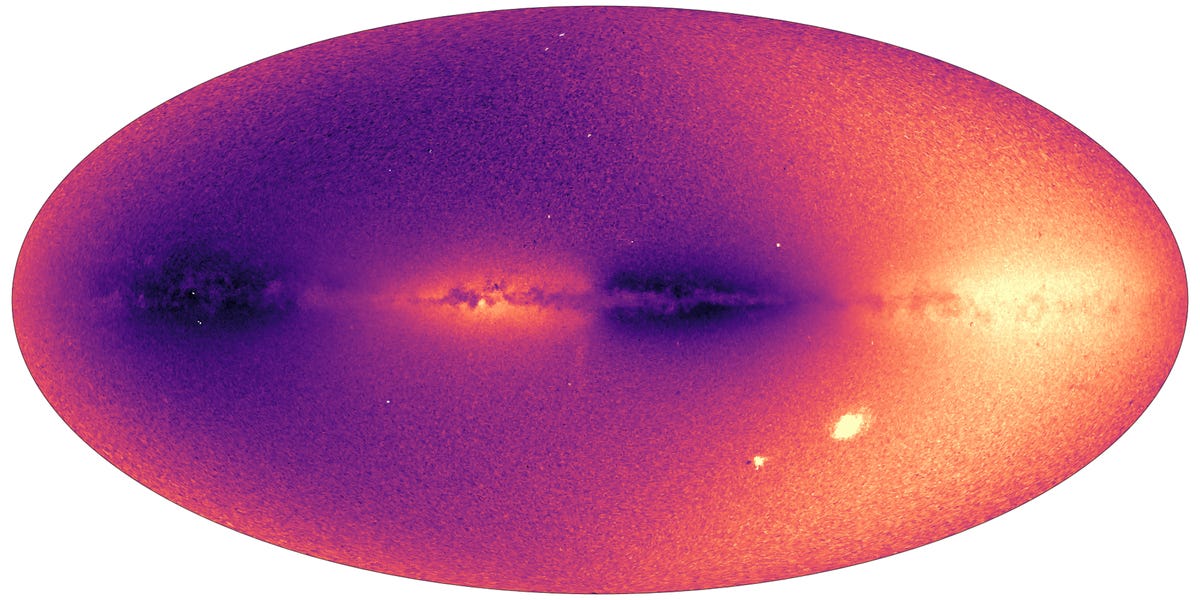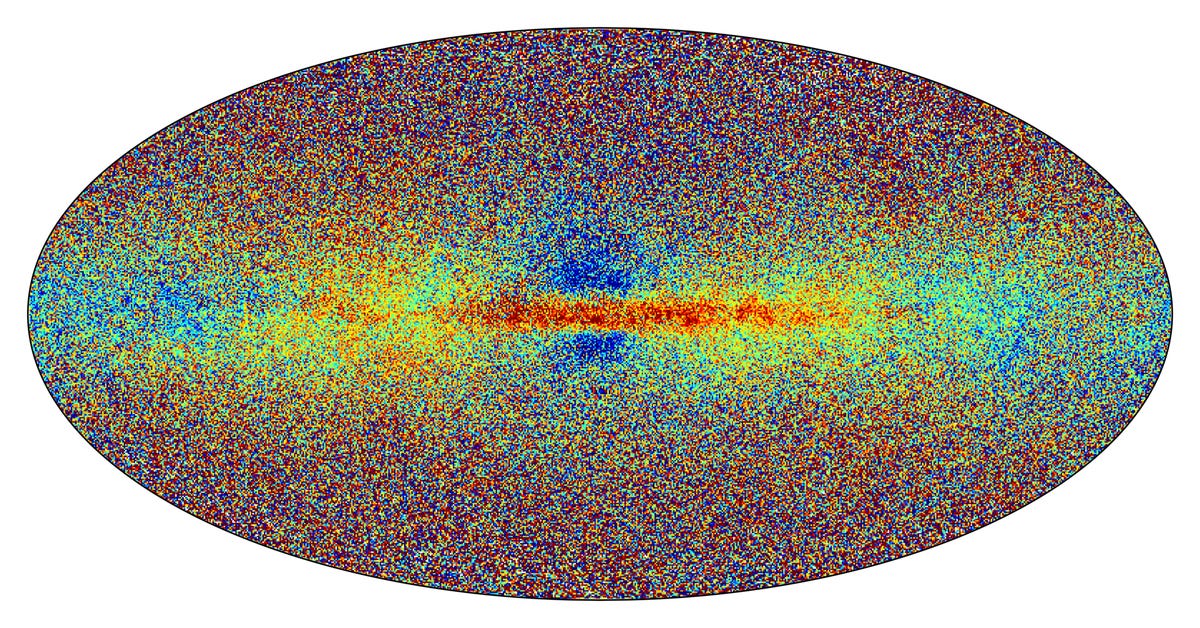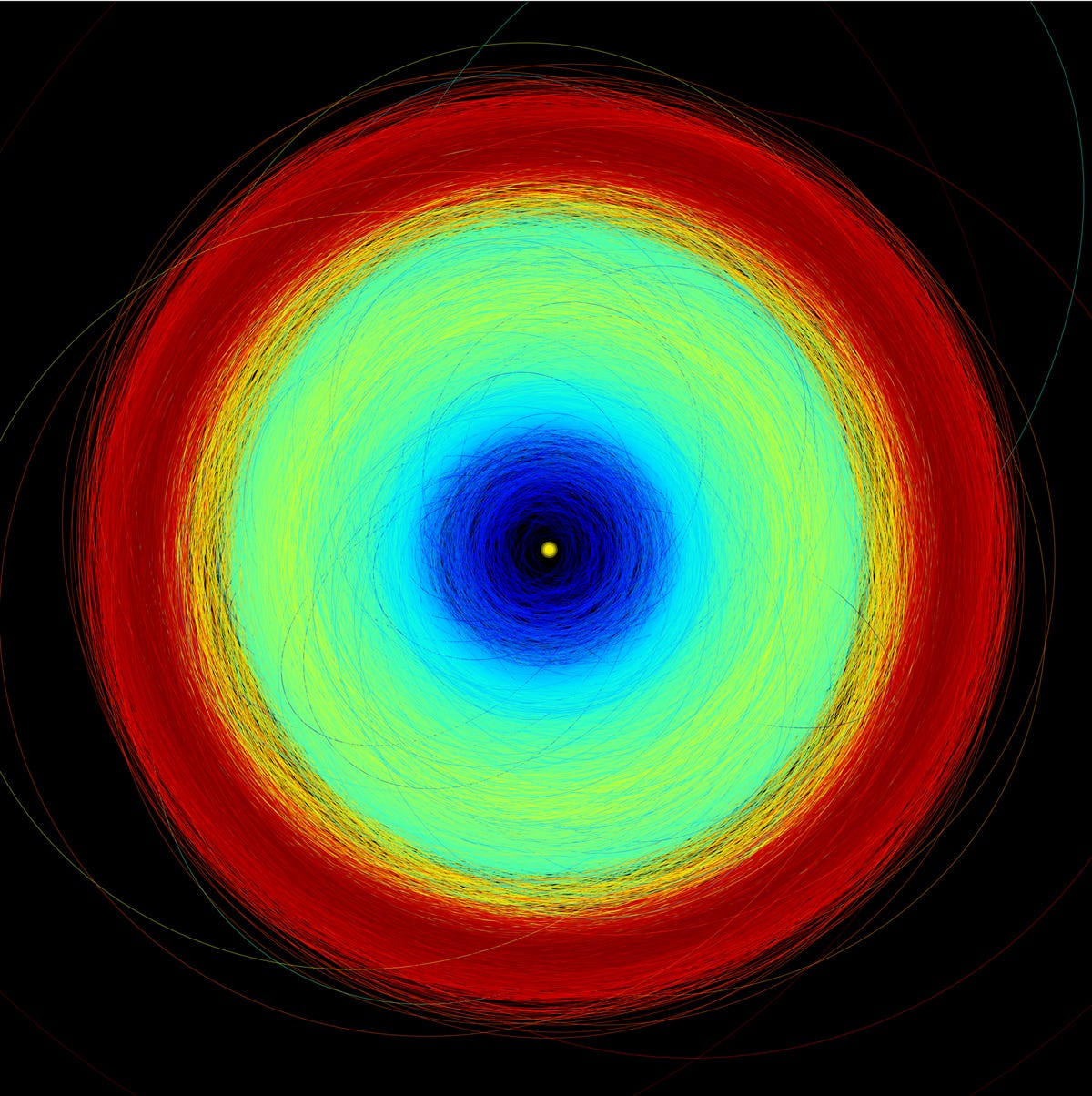
Scientists Are Building the Ultimate Milky Way Map. Here's What They Have So Far
Beyond the realm of mind-blowing spaceflight, groundbreaking satellites and stunning moon landings, the European Space Agency is focused on one crucial quest. It's simply to "create the most accurate and complete multidimensional map of the Milky Way."
The ambitious endeavor is called Gaia, and for the last several years, ESA has been steadily making progress on the dream. Scientists who're part of the collaboration have collected tons of spectacular data about the more than 1 billion stars throughout our galaxy, recording every juicy detail along the way.
And on Monday, the team reached a massive checkpoint for the project.
Lucky for us, it also released some remarkable visuals, which encompass the treasure box of cosmic secrets gathered so far. This particular milestone is formally referred to as Gaia data release 3, and importantly, it's one that ESA says is the "most detailed Milky Way survey to date."
In this dataset, not only can you see thousands of solar system objects, like asteroids, moons and other celestial marvels within our galaxy, but you can also peruse millions of galaxies and phenomena outside the Milky Way.

The position of each asteroid at 12:00 CEST on June 13, 2022, is plotted. Blue represents the inner part of the solar system, where the near-Earth asteroids, Mars crossers and terrestrial planets are. The main belt, between Mars and Jupiter, is green. The two orange "clouds" correspond to the Trojan asteroids of Jupiter.
P. Tanga (Observatoire de la Côte d'Azur)When you look at the stats of this survey, it really is jaw-dropping. This new wealth of galactic intelligence includes some 6.6 million quasar candidates with redshift estimates, aka the extremely bright jets that power supermassive black holes, and probably their precise locations. It boasts 4.8 million galaxy candidates, about 813,000 multistar systems, 2.3 million hot stars and so much more.
"Gaia is a survey mission. This means that while surveying the entire sky with billions of stars multiple times, Gaia is bound to make discoveries that other more dedicated missions would miss," Timo Prusti, project scientist for Gaia at ESA, said in a statement.

The Large and Small Magellanic Clouds appear as bright spots in the lower right corner of the image. The Sagittarius dwarf galaxy is visible as a faint quasi-vertical stripe below the galactic center.
ESA/Gaia/DPAC/CU6, D. Katz, N. Leclerc, P. Sartoretti and the CU6 team.According to the team, among the most surprising discoveries of Gaia's data release 3 are strange phenomena called "starquakes."
Starquakes are pretty much exactly what they sound like – tiny motions on the surface of a star that can alter its orblike shape. Some of these quakes ESA compares to vibrations we associate with "large-scale tsunamis" on Earth.
"Starquakes teach us a lot about stars, notably their internal workings. Gaia is opening a goldmine for 'asteroseismology' of massive stars," Conny Aerts of KU Leuven in Belgium, and a member of the Gaia collaboration, said in a statement.
Asteroseismology is to stars what seismology is to Earth, the study of quakes and other such wave propagation. A rundown of the starquake portion of Gaia's new data can be seen below.
Another striking revelation was that the Gaia telescope duo – which harnesses a whopping 1-billion-pixel camera – could detect the chemical composition of the stars being studied. This one's a big deal that could revolutionize the field of astronomy.
In short, understanding the breakdown of which exact chemicals lace stellar objects could help us decode when they were born, where they were born and what trajectory they followed after they were born. It could reveal a timeline of the universe.
And with the new Gaia data, the team found that some stars had heavier elements than others. Heavier elements are often metals, and differentiate themselves from lighter elements because they have a different nuclei structure.

This all-sky view shows a sample of the Milky Way stars in Gaia's data release 3. The color indicates the stellar metallicity. Redder stars are richer in metals.
ESA/GaiaBut the main point here is that lighter elements, from what experts know thus far, are thought to be the only kind present during the Big Bang. In essence, this means Gaia data release 3 offers direct proof of a super diverse combination of stars in our galaxy in terms of both time and place of genesis.
"This diversity is extremely important, because it tells us the story of our galaxy's formation," Alejandra Recio-Blanco of the Observatoire de la Côte d'Azur in France, and a member of the Gaia collaboration, said in a statement. "It reveals the processes of migration within our galaxy and accretion from external galaxies."

This sky map shows the velocity field of the Milky Way for about 26 million stars. Blue shows the parts of the sky where the average motion of stars is towards us, and red shows the where the average motion is away from us.
ESA/Gaia/DPAC/CU6, O. Snaith, D. Katz, P. Sartoretti, N. Leclerc and the CU6 team.Taking this all a step further, viewing the efforts of Gaia kind of reminds us of our place in the universe. Mapping a region far, far vaster than Earth's immediate neighborhood inevitably forces human existence into perspective.
As Recio-Blanco puts it, "It also clearly shows that our sun, and we, all belong to an ever changing system, formed thanks to the assembly of stars and gas of different origins."
Other remarkable sightings with Gaia include over 800 binary star systems, which refer to two stars orbiting one another, in contrast to our solar system's singular sun, and a new asteroid survey comprising 156 ,000 rocky bodies.

This image shows the orbits of the more than 150,000 asteroids -- from the inner parts of the solar system to the Trojan asteroids at the distance of Jupiter. The yellow circle at the center represents the sun. Blue represents the inner part of the solar system, where there are near-Earth asteroids, Mars crossers and terrestrial planets. The main belt, between Mars and Jupiter, is green. Jupiter Trojans are red.
P. Tanga (Observatoire de la Côte d'Azur)"We can't wait for the astronomy community to dive into our new data to find out even more about our galaxy and its surroundings than we could've imagined," Prusti said.
And with regard to Gaia's own next steps, the team intends to continue toiling away at what will eventually be the pinnacle of lore for our home galaxy, the Milky Way.

This image shows an artistic impression of the Milky Way, and on top of that an overlay showing the location and densities of a young star sample from Gaia's data release 3 (in yellow-green). The "you are here" sign points towards the sun.
ESA/Kevin Jardine, Stefan Payne-WardenaarSource
Tags:
- Why Are The Glasses Of Building Milky
- Are There More Milky Ways
- Scientists Chained To Building
- Science Is Built Up With Facts
- The Work Of Scientists Begins With
- Nasa Scientists Working In Building 9
- Scientists Are Constantly Learning
- Scientists Are Mapping Reading Answers
- Scientists Are Experimenting With A Kind
Blog Archive
-
▼
2023
(218)
-
▼
January
(95)
- Why I Was Completely Wrong About Fortnite
- Facebook And Instagram Turn Off AR Filters In Texa...
- Amazon Just Cut $80 Off The Price Of This HP Touch...
- Sony Vaio T13 Touch Review: Sony's Solid Ultrabook...
- Gamescom Opening Night Live: How To Watch Online, ...
- Samsung Galaxy S10 Plus Review: Killer Cameras And...
- MTV VMAs: Eminem And Snoop Dogg Perform As Bored A...
- Shop A Selection Of Refurb Samsung Smartphones Sta...
- Laptop Buying Guide
- Ocean Drone Caught Inside Hurricane Sam Captures H...
- Best AirPods Deals: $69 Off AirPods Pro, $100 AirP...
- Tesla Recalls Nearly 600,000 EVs Over Boombox Feat...
- Dusty NASA Mars Lander Snaps What Will Likely Be I...
- Check Your Capri Sun: Thousands Of Cases Recalled ...
- The HP Chromebook X2 11 Is On Sale For $399 At Bes...
- Motorola Moto G Review: The Price You Want, But No...
- Spotify's Car Thing Is About To Face The Music
- 'Stranger Things 4' Beats 'Bridgerton' In Netflix'...
- WeChat Ban On Hold For Now, But You Can Still Try ...
- Microsoft Spring Sale: Big Discounts On Laptops, K...
- It's 2022, And I'm Still Losing My Apple TV Remote
- OnePlus 10T Scraps Alert Slider, Adds 'Crater' Cam...
- Oppo Unveils 5G Phone, 48-megapixel Camera Phone W...
- GM Announces Chevy Equinox EV, Blazer EV At CES 2022
- Lightroom Masking Arrives, Bringing A Major Upgrad...
- Facebook Pay Will Let You Send Money On Messenger,...
- What To Expect From The Housing Market In 2022: An...
- Think You're A Wordle Badass? Octordle Will Humble...
- This Week's Top Bitcoin And Crypto News: NFT Of Ja...
- Huawei CFO Meng Wanzhou Enters Agreement With Just...
- Phone Won't Charge? Try This Easy DIY Toothpick Tr...
- Save $350 On The DJI Mavic Air Drone (Update: Sold...
- Scientists Are Building The Ultimate Milky Way Map...
- Thunderstorms Delay, Cancel Thousands Of US Flight...
- SEC Expands Crypto Enforcement Unit To Combat Fraud
- The Best Comedies On Netflix You Absolutely Need T...
- Strengthen Your Heart Health With These Workouts
- Unplug These Appliances To Save $100 Each Year
- Google's Parti Generator Relies On 20 Billion Inpu...
- Facebook Pay Will Let You Send Money On Messenger,...
- Twitter Bans Sharing Photos, Video Of People Witho...
- Hyundai, Kia Set To Cancel K5, Stinger, Sonata In ...
- Back-to-School Shopping On A Budget: Where To Buy ...
- Save Big On Mattresses And Furniture With These La...
- Xiaomi Phones Briefly Appear, Disappear On US Mobi...
- Microsoft Is Building AI Antivirus Using 400 Milli...
- Nvidia GeForce RTX 3050 And 3050 Ti Promise $799 R...
- Missing IPhone Texts And Notifications Are Frustra...
- Having Trouble Feeling Alerts On The Apple Watch? ...
- Mercedes To Discontinue Metris, Gas-Powered Sprint...
- Best Buy's Flash Apple Sale Offers Huge Discounts ...
- HBO Max, Discovery Plus' New Parent To Be Named Wa...
- Asus ZenBook Pro 15 Review: A Second Screen Under ...
- Smartphones In 2018: The Biggest Winners And Losers
- 4 Things We Just Learned About The Future Of GoPro
- The Latest Android 13 Developer Preview Is Availab...
- Apartment Utilities Are Getting More Expensive: 10...
- Best HP Laptops For 2022
- Honeywell's Robust DIY Security System Has Potential
- LG C2 OLED TV Review: Early Favorite For Best High...
- Westworld Season 3 Gets Futuristic Gadgets And Tec...
- Tesla's Phantom Braking Concerns Spark Federal Inv...
- How To Get Shiny Meltan In Pokemon Go
- See Google's AI-Powered Robot At Work In A Kitchen
- The Ghost Particle: What Is A Neutrino And Could I...
- Samsung Launches Galaxy S21 Cases Made From Biodeg...
- Why You Shouldn't Take Your Indoor TV Outside For ...
- The Best Phones Of 2020
- A Typo Sent $36 Million Of Crypto Into The Ether
- 5 Tasty Kitchen Deals Under $50 Today
- Laptops Are Adapting To Our New Normal In 2022
- Tesla Wasn't Ready After Elon Musk Demanded Employ...
- Which MacBook Air M2 Charger Should I Get?
- Blue Cash Preferred Card From American Express: Ge...
- New IOS Malware Tricks Its Way Onto IPhones In Chi...
- 2022 Is The Year Of The Electric Car. Here Are The...
- Spotify's Car Thing Is About To Face The Music
- Saudi Arabia Threatens To Ban Skype, WhatsApp, And...
- Snapchat's Time Machine AR Lens Creepily Shows Wha...
- Save $40 On Ninja's Freakishly Versatile Multicook...
- Apple's IMessage Should Improve Texting To Android...
- Snapchat's Newest AR Effects Work With Apple's IPh...
- Windows 7 To 10 Upgrade: Seriously, Here's Why You...
- Best Buy Deals: Top Discounts Available This Week
- The Upgraded 2022 Moto G Stylus Is A Downgrade In ...
- New IOS Malware Tricks Its Way Onto IPhones In Chi...
- No Student Loan Forgiveness? Take A Look At Loan R...
- Bitmoji's Friendmoji Are Breaking Out Of Snapchat ...
- AMD's Ryzen 7000 Gives High-End PCs A 29% Speed Boost
- Is Caffeine Really Bad For You? A Doctor Weighs In
- US Presses British Officials To Block Huawei From ...
- WWE Hell In A Cell 2022: Start Times, How To Watch...
- How To Find And Use A Chromebook's Local Storage
- Icebergify: Here's How To Create An 'Iceberg' Of Y...
- Samsung Accused Of Misleading Customers On Galaxy ...
-
▼
January
(95)
Total Pageviews
Search This Blog
Popular Posts
-
Contoh skripsi, contoh skripsi perpajakan, contoh skripsi pdf, contoh skripsi keperawatan, contoh skripsi pgsd, contoh skripsi e learning, c...
-
Contoh discussion text about handphone samsung, contoh discussion text about handphone terbaru, contoh discussion text about handphone acces...
-
Contoh form data karyawan, contoh form data karyawan baru, contoh formulir, contoh formulir kesediaan, contoh formulir bahasa inggris, conto...
